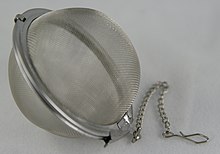This article needs additional citations for verification .(February 2009) |

A tea infuser is a device in which loose, dried tea leaves are placed for steeping or brewing, in a mug or a teapot full of hot water. It is often called a teaball, tea maker or tea egg. [1] The tea infuser gained popularity in the first half of the 19th century. Tea infusers enable one to easily steep tea from fannings and broken leaf teas. [2]

